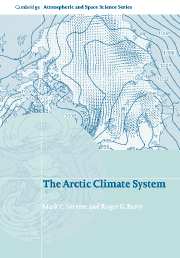Book contents
- Frontmatter
- Contents
- Preface page
- Acknowledgements
- List of Abbreviations
- 1 The evolution of knowledge about the Arctic and its climate
- 2 Physical characteristics and basic climatic features
- 3 The basic atmospheric heat budget
- 4 The atmospheric circulation
- 5 The surface energy budget
- 6 Precipitation, net precipitation and river discharge
- 7 Arctic ocean–sea ice–climate interactions
- 8 Climate regimes of the arctic
- 9 Modeling the arctic climate system
- 10 Arctic paleoclimates
- 11 Recent climate variability, trends and the future
- References
- List of selected websites
- Index
- Plate Section
7 - Arctic ocean–sea ice–climate interactions
Published online by Cambridge University Press: 10 August 2009
- Frontmatter
- Contents
- Preface page
- Acknowledgements
- List of Abbreviations
- 1 The evolution of knowledge about the Arctic and its climate
- 2 Physical characteristics and basic climatic features
- 3 The basic atmospheric heat budget
- 4 The atmospheric circulation
- 5 The surface energy budget
- 6 Precipitation, net precipitation and river discharge
- 7 Arctic ocean–sea ice–climate interactions
- 8 Climate regimes of the arctic
- 9 Modeling the arctic climate system
- 10 Arctic paleoclimates
- 11 Recent climate variability, trends and the future
- References
- List of selected websites
- Index
- Plate Section
Summary
Overview
The mean seasonal variation of sea ice extent was reviewed in Chapter 2 along with some basic aspects of sea ice circulation, morphology and the factors contributing to sea ice growth. As introduced there, the existence of the ice cover is not simply a function of low winter temperatures – its formation and persistence is fostered by the existence of a relatively fresh surface layer, maintained in relative order of importance by river runoff, the import of low-salinity water through the Bering Strait and net precipitation over the Arctic Ocean. The characteristics of river runoff were examined in Chapter 6. In Chapter 3, we discussed the role that sea ice plays in the Arctic's atmospheric heat budget, with sea ice melt drawing heat out of the atmospheric column in summer, and sea ice growth adding heat to the atmospheric column in winter. Chapter 5 shed further light on this issue through a review of the surface energy budget. In Chapter 4, we documented sea ice impacts on regional aspects of the circulation through enhanced baroclinicity along the ice margins. The present chapter extends our understanding of sea ice and its interactions with the atmosphere and ocean.
The growth of sea ice up to about 1 m in thickness can be approximated in terms of freezing degree days. This is because the temperature gradient in thin ice is essentially linear. By contrast, the growth of thicker ice, primarily multiyear ice, is complicated by non-linear vertical temperature gradients.
- Type
- Chapter
- Information
- The Arctic Climate System , pp. 177 - 207Publisher: Cambridge University PressPrint publication year: 2005
- 1
- Cited by



